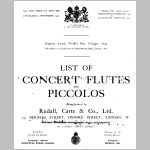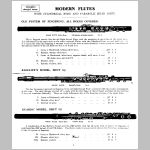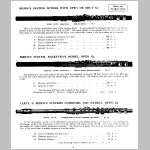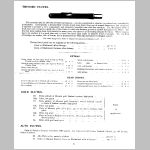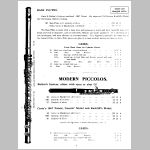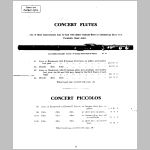Rudall, Carte & Co. catalog, September, 1922
The venerable firm of Rudall, Carte & Co.
began as Rudall & Rose (1821–1852), became Rudall Rose Carte & Co. (1852–1871),
and operated as Rudall, Carte & Co. past 1950. They
offered a wide variety of flutes from the beginning, and were
instrumental in manufacturing and promoting the Boehm flute and other
cylindrical flutes in England.
Thanks to Joe Moir for providing a copy of this catalog.
Scanned images of pages 1 and 4 through 8 may be found below.
Pages 2 and 3 consist of "General Remarks", which are of
great interest, and these Remarks are reproduced as text below
the thumbnails.
Rudall, Carte's offerings consist primarily
of what they term Modern Flutes, by which they
mean cylindrical bore flutes with "parabolic" head joints.
This includes: "old system" flutes, Radcliff's Model, Guard's Model,
Boehm's system, Rockstro's Model, Carte 1867 patent flutes.
The "old system" modern flute (almost an oxymoron) had "some
traces of the inherent defects of the old Flute" since the holes
could not be put in "their absolutely correct positions".
They also offer, on the very last page, "Concert Flutes", including
conical 8-key flutes.
Click on the thumbnails, or
click here to return to the Flute Catalog Excerpts index.
GENERAL REMARKS
Pages 2 and 3 of Rudall, Carte's
List of Concert Flutes and Piccolos, from September, 1922
SOME explanation about the Flutes manufactured by Messrs. Rudall, Carte & Co., Ltd.,
may be useful to
those who have no opportunity of seeing and examining them together.
There are two classes of Flutes; those with, the Conical, and those with the
Cylindrical Bore. Up to the
year 1847 all Flutes were made with the Conical Bore, excepting the Fife,
which has now gone out of use.
In the Conical Flutes the head or top joint into which the performer blows has
a cylindrical bore, and in
the body and foot joints the bore becomes gradually smaller towards the end of the
instrument. In the
Cylindrical Flutes, on the contrary, the body and foot on which the keys are,
are cylindrical, and the head joint
tapers towards the top. The cone, in this case, is not a straight taper,
but is slightly curved, forming a section
of a parabolic curve. In the Conical Flutes there were many different bores employed,
some large, some small, and
varying in numberless particulars. It was from the manufacture of their
Eight-Keyed Flutes that Messrs. Rudall
& Rose, the predecessors of the present firm, first became celebrated as Flute Makers.
The Old Conical Flute
was distinguished for its sweet tone combined with considerable power,
and it was a remarkably popular
instrument in England. At the present day, when we compare it with those now used,
it is difficult to account
for the enthusiasm which it formerly inspired.
Among the serious defects in it we may refer to the fact that
the six holes covered by the first, second and third fingers of each hand had to
be placed where they could be
reached conveniently, and that, in consequence, their correct size and
position had to be sacrificed, with
the necessary results of incorrect tuning, and inequality in the tone of the
different notes. The absence of a
proper hole for C natural, too, necessitated the use of an artificial
note, i.e. a C sharp made to sound flat by
placing some of the fingers on the lower boles. The muffled note thus
produced was a remnant of the old one-
keyed German Flute, on which many of the notes were produced in this faulty way.
The notes again, were not
properly vented; the necessity of having the hole below the one giving the sound open,
in order to make the
tone free, not being then recognised.
The Fifes formerly used in the Army were made with a Cylindrical Bore throughout.
It was found that
larger Flutes could not be made in this way, and the Fife itself, years ago,
gave place to small conical Flutes and
Piccolos. It is curious that the Fife, which gave way to these conical small Flutes,
should have contained in it
the germ of that bore which eventually was to carry all before it. The modern Flute,
as has before been stated,
is a cylinder with a parabolic head-joint.
With the Cylindrical bore, which was patented by this firm in 1847
for England and France,
and is now in
universal use, were introduced other improvements of vast importance.
Great efforts had been made immediately
before this to remove some of the glaring defects of the instrument.
Attempts had been made to facilitate the
fingering, and, above all, to get the holes in their true places.
It was only with the Cylinder, however, that the
modern ideas were really developed and established, and that the great
principle was realised that the holes must
be put in their really correct positions first,
and the means of covering them must be found afterwards.
The primary cause of the great success of the modem Flute is, that in consequence
of the holes being in their
theoretically correct positions, the tuning is, practically speaking,
perfect, and the notes equal in quality and
volume. With this happy union of theory and practice have been joined the
singular beauty and variety of tone
of the Cylinder bore, and the great faculties offered by the new systems of fingering.
Combining, as it does, all
these advantages, it cannot be a matter of surprise that the modem form of
the instrument should have taken
such a firm hold of the whole of the Flute-playing world.
The Cylindrical Flutes are made with several systems of fingering,
but with the exception of that on the
Old System, which retains to a certain extent some of the defects of the old flute,
the tone and tuning in all of
them may be considered equally perfect. One of the peculiarities of this bore
is the ease with which the sound
is produced; in this it contrasts very favourably with the Old Conical Flute,
on which much skill was always
requisite to produce at all a soft tone which was up to pitch, and was not feeble.
The different systems of
fingering are described under their separate headings.
The bodies of the Flutes are chiefly made of Silver, Wood, Ebonite or Gold.
Which material is selected
is purely a matter of taste, for each has its peculiar qualities.
The Cylindrical Flutes were first made of silver,
the tone of which is sweet and delicate. Flutes of this material have to be
played with a looser lip than either
those of the Wood or Ebonite, and this has led some to think them better
suited to people who do not play
much than those made of the two latter materials, as a firm lip is
only to be kept up by practice. Cocus and
Blackwood, owing to their durability and fitness generally for the purpose,
have caused them to be very much
used in the manufacture of Flutes, Clarinets and other instruments.
The tone which it produces is rich and
powerful, combined with a rounded quality so thoroughly characteristic of the Flute.
Ebonite, a preparation of
india-rubber, which has been used for some years in the manufacture of Flutes,
is in some respects very similar
to the Cocuswood. It has more resistance than Silver, but hardly so much as Cocus
or Blackwood. The tone seems
to have a slightly softened character, quite peculiar to the material.
Ebonite never cracks in any climate.
Gold, as a material for Flutes, has several distinctive peculiarities,
which are very important. The tone is delicate,
liquid and sympathetic in a high degree, and this goes hand in hand with much more
resistance and greater
richness than is found in Silver. Its remarkable qualities are due to the great
density of the metal, to the closeness
of each other of the particles which constitute it; this undoubtedly greatly
influences the vibration.
There have been several theories put forward on the subject of the size of the holes,
but it is now generally
recognised by the Musical Profession, as the result of practical experience,
that they should not be too large.
One idea was that, as by opening a hole the tube is,
practically speaking, temporarily cut off at that point, the
hole should be made as large as possible, so as to produce the effect of cutting
off thoroughly. Experience has
shown, however, that this is undesirable, as the tone becomes wild and unmanageable.
Another theory was
that the instrument was in effect a set of open diapason Pandean Pipes combined in
one tube, and that the holes
should therefore become smaller the nearer they are to the embouchure. It was lost
sight of, however, that as
the bore remained the same, the Pandean Pipe theory must fall to the ground.
It would be necessary to have
a separate Flute, with a different bore for each note, to carry it out.
When these Flutes were first introduced they were made with what are called the
small holes; since then,
the large and medium sizes have been introduced. When the medium holes are used,
it is found desirable to
increase the size of the three lowest holes, but in order to preserve the balance
they are not made too large. The
late Mr. Clinton carried the size of these holes to an extreme,
but they have not become popular. Practical
experience must, after all, be the sure guide in these matters, and this has
undoubtedly shown that, though the
increase made in the size of the holes was a great stride in Flute-making,
it does not do to carry it too far; there
may, perhaps, be a gain of loudness close at hand, but there is,
undoubtedly, a loss of quality and carrying power.
